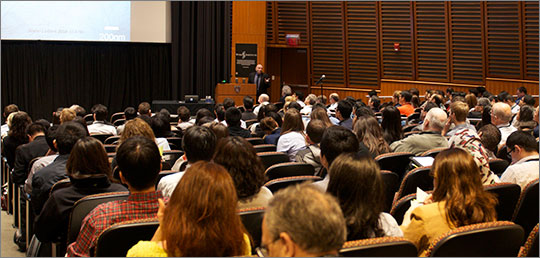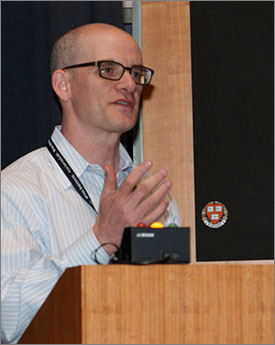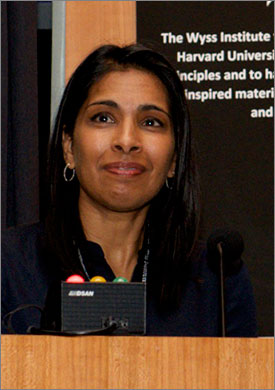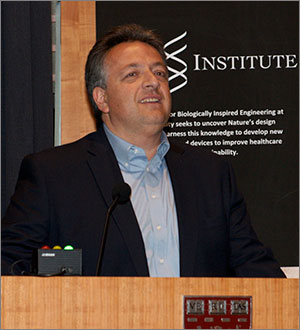Wyss Institute's International 2013 symposium covers latest bioinspired nanoscale therapeutics and diagnostics
In the 1960s sci-fi film “Fantastic Voyage,” a miniaturized crew traveled through the bloodstream of a comatose scientist in a tiny submarine on a mission to dissolve a life-threatening blood clot in his brain. According to innovations presented at yesterday’s fourth annual Wyss Institute symposium, tiny robots and other molecular machines can now do jobs like this. What used to be fodder for science fiction has now become possible.

“We are getting better and better at innovating in these areas and at a pace that continues to accelerate,” said Wyss Founding Director Don Ingber. In more than a dozen presentations throughout the day, scientists from the Wyss Institute, its collaborating institutions and other universities revealed how the lines between living and non-living systems have begun to blur, thereby revealing exciting new landscapes for nanotherapeutics and diagnostics.
The all-day symposium — held at Harvard Medical School’s Joseph Martin Conference Center in Boston — drew an energetic crowd of 400 clinicians, doctors, industry leaders, faculty, and students from 15 countries. In total, they represented about 70 universities and organizations. The invited speakers offered a buffet of advances in targeted drug delivery, self-assembling nanomaterials, and regenerative medicine — and also addressed the critical challenges involved in translating these innovations into commercialized technologies.

The symposium kicked off with presentations on nanotechnologies that ferry drugs to tumors and other diseased tissues. “We have a tremendous need for disruptive innovation in therapies for cancer,” said Sangeeta Bhatia, MIT’s Wilson Professor of Health Sciences and Technology and a Howard Hughes Medical Institute Investigator. That’s because curing cancer in patients is much harder than killing it in a petri dish. This theme was echoed throughout the day by many speakers, including symposium co-chairs Ingber and Wyss Institute Core Faculty member Dave Mooney.
In designing cooperative nanosystems for cancer diagnosis and therapy, Bhatia said 99 percent of injected cancer-fighting nanoparticles fail to make it to the tumor, so she’s trying to find ways to get more of them there to the tumor. Her team developed gold nanorods that send out signals that lure liposomes filled with anticancer drugs to tumors.
Ingber drew inspiration from the body’s platelets — integral players in blood clotting — which are affected by shear stress as they travel through the bloodstream. His team designed nanoparticles that act like a wet ball of sand – clumping, then breaking apart when subjected to shear stress in fast-flowing fluid. This delivered clot-dissolving nanotherapeutics to dissolve vascular blockages. “We are extremely excited about this because it’s a platform technology that could help treat stroke, pulmonary embolism, heart attacks, coronary artery disease, and more,” Ingber said.
He also described another platform technology developed at the Wyss, in which magnetic nanobeads pull pathogens and toxins from the bloodstream of patients with sepsis — a condition with a mortality rate of 30 percent.
Moving from the blood to the brain, Wyss Core Faculty member George Church discussed new high-capacity gene synthesis and sequencing technologies, in addition to advancements in neurotechnologies that align with President Obama’s recently announced Brain Initiative.

“Innovative neurotechnologies are definitely up the alley of the Wyss Institute,” Church said.
Wyss Core Faculty member Peng Yin discussed his team’s work assembling DNA and RNA into two-and three-dimensional nano structures—innovations that are not yet ready for the clinic, but could yield impressive applications. “We now have an unprecedented capability to design sophisticated structures at the nanoscale,” he said, and these structures could one day be used as drug-carrying cargo vehicles, in sophisticated super-resolution molecular imaging, and more.
Sam Stupp, Director of the Institute for BioNanotechnology in Medicine and Louis A. Simpson and Kimberly K. Querrey Center for Regenerative Medicine at Northwestern University, was inspired by protein fibers in the extracellular matrix, the glue-like network of proteins and other molecules that holds cells in place and knits them into tissues. His team has created analogous nanofibers that bundle together into a noodle-like structure that serves as a highway to guide nerve fiber regrowth — a bioinspired nanotechnology that could one day help reverse paralysis and treat erectile dysfunction. Related nanofibers could one day help guide bone formation, he said, providing a possible treatment for skeletal birth defects and traumatic bone injuries.
Samir Mitragotri, the Founding Director of the Center for Bioengineering at the University of California, Santa Barbara, discussed blood cells called monocytes that can carry particles like backpacks to treat cancer, atherosclerosis, and inflammation – and Trevor Douglas, Director of the Center for Bio-inspired Nanomaterials at Montana State University, discussed protein cage nanoparticles (PCN) of all shapes and sizes that could protect against influenza.

In a session called “From the Bench to the Marketplace,” Mooney discussed a new implantable cancer vaccine that harnesses the body’s own immune system to fight melanoma and possibly other kinds of cancers and inflammatory conditions as well. And just when it felt like there couldn’t possibly be any more innovative ideas for treating disease on the table, Nicole Steinmetz from Case Western Reserve University discussed her team’s work using various plant viruses as delivery vehicles that could help treat cervical cancer, breast cancer, and more.
“There are at least 1001 good reasons to choose virus nanoparticles as cargo delivery systems, but in the interest of time I’ll just name a few,” she said. In short, plant viruses are considered safe from an immune perspective, and are fairly easy to produce and genetically modify as needed.
The spirit of collaboration and innovation — hallmarks of the Wyss Institute – was palpable and acknowledged in each session symposium. Equally paramount to the Institute is a focus on technology translation, discussed at length in the closing keynote by Noubar Afeyan, Managing Partner and CEO of Flagship Adventures. Afeyan has had a hand in 26 start-up ventures to date.
Even the best bioinspired technologies won’t help patients unless they can be commercialized, said Afeyan, who offered key lessons in commercializing new biotechnologies. For starters, if you want to realize your entrepreneurial innovation and translate your technologies, you have to adopt an extreme sense of optimism – and understand that only “paranoid optimists” succeed. This was Afeyan’s spin on the popular book about leadership philosophy entitled, “Only the Paranoid Survive.”
What’s more, Afeyan said, it’s important to be prepared to speak the language of value creation, conduct market analyses, and understand the difference between an idea and a product. Finally, biotech entrepreneurs should be prepared to pursue strategic alliances with large pharmaceutical companies because they will best position technologies for commercial success. “Most innovative technologies will be launched through a large company,” he said.
In his closing remarks, Ingber said, “One of the reasons we formed the Wyss Institute for Biologically Inspired Engineering was because the boundaries between living and non-living systems were breaking down – and that’s what we saw today. We are going through a real paradigm shift, and I hope you get a sense that nanotech today isn’t what it was even three years ago.”